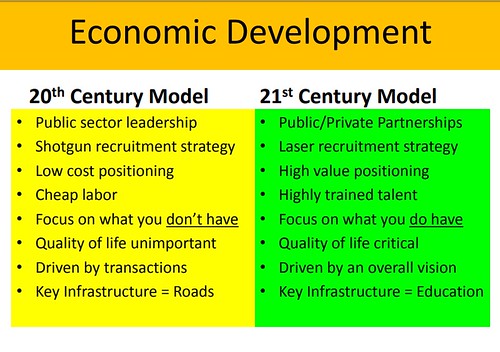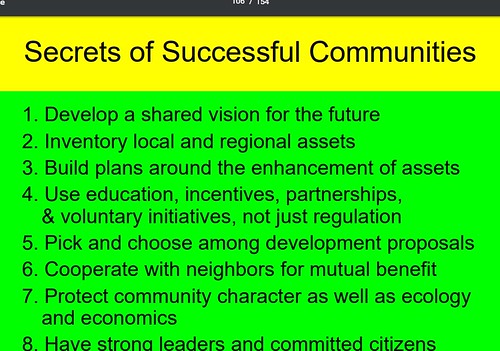North Carolina Main Street presentations
I was at a farmers market today, talking to some people working on Main Street programs in DC, and I wasn't particularly cheerful.
I have learned so much about how commercial district revitalization works and it amazes me that DC, despite having a Main Street program for 16 years, and many programs across the city, hasn't really codified the learning that has occurred across programs both in terms of success and failure, doesn't leverage the value of commercial district revitalization programs as a network, doesn't have the same commitment to technical training that it did at the outset, and has a two sizes (Business Improvement Districts for bigger places and Main Street for smaller places) fits all approach to commercial district improvement when a greater range of approaches and a more defined set of supports is needed.
Despite being down about this here, I happened to come across the North Carolina Main Street website and they are featuring their annual conference which was in March, and have almost all of the presentations up on the site.
The two plenary presentations were by Ben Muldrow, of Arnett Muldrow, a planning consulting firm that uses design and branding methods in their approach to commercial district revitalization planning and Ed McMahon, now a fellow at the Urban Land Institute, who is a national leader on the value of aesthetics and design in defining and maintaining community identity.
-- The Future of American Downtown – Ben Muldrow
-- 21st Century Economic Development – Ed McMahon
Both presentations are very good. ... I'm not sure I've heard Ben Muldrow speak. If not it was someone else from his firm at the 2005 National Main Street Conference in Baltimore, and it was mind blowing to see how they applied the design method and branding to "land use planning" and commercial district revitalization.
I've seen Ed McMahon speak a few times, and he is always good at rekindling the desire to keep at this work.
This is a slide from Ed's presentation, where he contrasts 20th and 21st century approaches to economic development. I particularly liked the line about "transaction vs. vision" in driving projects.

It's funny. There's a slide in the McMahon presentation featuring a photo of the book, Cities: Back from the Edge by Roberta Gratz, and that was the one book I recommended to the woman I talked to at the booth.
I always say if you only have time to read one book on commercial district revitalization, that's the one, because it's easier to grasp than Jane Jacobs as it is more of a set of vignettes or case studies of various improvement initiatives.
Both keynote presentations key on the value of place and distinctive communities as a way to attract and keep "capital." I don't feel like elected officials and stakeholders really understand and believe that here in Washington.
I first wrote about this in 2005:
-- "Town-City Branding: We are all "destination managers" now"
The book I mentioned in that post, Tourism Development Handbook: A Practical Approach to Planning and Marketing by Kerry Godfrey and Jackie Clarke is for the most part, excellent, and I am surprised it is out-of-print. It's applicable to commercial district revitalization as much as it is to tourism.
The point I made in the blog entry is that if we make places great for ourselves, often they'll be attractive to visitors as well, and the additional spending by the visitors will help support a broader range of retail and services.
The book I am trying to read in preparation for some posts in advance of World Tourism Day (September 27th), is The Competitive Destination: A Sustainable Tourism Perspective. It's even more of a primer than the other.
(Unlike states like North Carolina, New Jersey, Connecticut, and others, DC doesn't have an annual Main Street training conference, although various organizations do various economic development presentations throughout the year.)
Secrets of Successful Communities, presentation slide, Ed McMahon, Urban Land Institute

Labels: commercial district revitalization planning, cultural heritage/tourism, destination management, land use planning, tourism marketing, urban design/placemaking, urban revitalization



0 Comments:
Post a Comment
<< Home